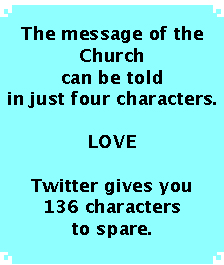 How Can A Blog Be Actionable?
How Can A Blog Be Actionable?
Yesterday’s post talked about the characteristics of a viral post — a post that readers share in large numbers. One of the characteristics is that a viral post is actionable.
An actionable post results in a reader doing something. When marketers use the term, they mean the reader either bought something or took a step towards buying something. Marketers have embraced blogging because they see it as a customer relations, customer retention and sales tool—all in one.
Churches have the same needs but use evangelical/ecclesiastic terminology.
Yet churches seem to be puzzled by the blogging genre. They tend to see a blog as an online musing . . . an extension of the sermon. It is so much more!
The easiest way to move away from this thinking and to begin to harness the power of the web is for churches to think in terms of writing blogs which prompt action.
In church terms, this could mean a number of things.
Here are some actions that could result from congregational blog posts:
- A reader might subscribe to your blog or the congregational newsletter. Your congregation could then reach subscribers with a short message every day. (They probably won’t sign up to read sermons, though!) 2×2 has about 63 subscribers and another 100 or more who subscribe via Facebook, Twitter or LinkedIn. We reach more than 500 new readers every week! (Imagine what we could do with a building!)
- A reader might share your post with someone else. I occasionally send links to Pastor Swanson’s daily emails, 7 Minutes A Day. I find them to be inspirational and motivating and hope others will, too.
- A reader might take some action they might not otherwise take. Pastor Swanson’s posts have prompted me to read more of the Bible and look at familiar Bible passages in a new light.
- A reader might become interested in a new ministry. A congregation could blog about homelessness and inspire someone to do something about it.
- A post might inspire someone to make a donation (sweat or dollars).
- A post might inspire a new understanding or make a new connection. I can’t remember how our posts led us to ministry friendships with Christians in Kenya, Pakistan, and Sweden, but they did!
- A post could spark an interest in personal growth. I was impressed with a captivating video of a young girl telling a Bible story. I shared it on our blog and was myself inspired to improve my storytelling skills.
- A blog post can lead to new alliances. Our early posts on the value of Vacation Bible Schools created alliances with like-minded Christians in other areas of the United States.
- A reader may comment on a post and that may spark an online conversation.
- A reader just might be inspired to faith and salvation.
How A Blog Might Impact A Common Scenario
In yesterday’s post, I posed a scenario where a congregation became aware that their neighborhood was changing. A new and very different ethnic group was moving in and changing the demographic. This isn’t a stretch. It’s happening all over our city (Philadelphia). A common result within our denomination is to declare churches closed in changing neighborhoods. We can only guess that they feel their message will not fly with the changing demographic. (Actually, we are not guessing, that’s what our church was told by our regional body.) This is foreign to the biblical mission of the church—and unnecessary—especially if congregations use social media as a mission tool!
What if a congregation started blogging about the changes in the neighborhood in a way which fostered interaction between the settled population and the newcomers. If they did so regularly, it would be noticed within a few weeks. Doors would open. Introductions would be made. When the new population began to show an interest as neighbors, they would feel like they already know the people who sponsored such a welcoming blog.
Civic organizations would likely notice, too. The church would gain respect in the neighborhood. The voice of the Church might carry more weight. Mainline news might notice. The possibilities are endless.
Actionable blogs should be a goal of every congregation.
Many of these benefits can be achieved without a blog. But there is no denying that blogging amplifies the likelihood and the reach of ministry efforts. It is work. It is a new discipline. But it is exciting. Time must be carved out to learn new skills. But the potential for ministry is so much greater with a blog than without. Frankly, the time invested in blogging will steal time from ministry efforts which may be traditional but which are not resulting in church growth. No real loss.
One last thing!
An actionable post should end with what in business is termed a Call To Action. This can be as simple as posing a question. Or it could be a simple form.
Here’s our Call to Action!
If you’d like help getting started in social media or blogging, submit the brief form below. We’ll see if we can be of service or point you in a helpful direction.
[contact-form-7 404 "Not Found"]




